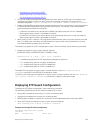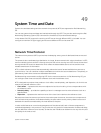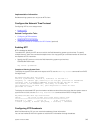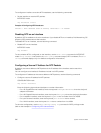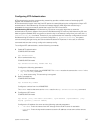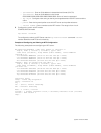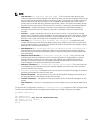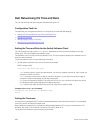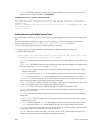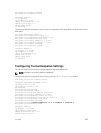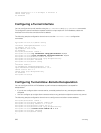
NOTE:
• Leap Indicator (sys.leap, peer.leap, pkt.leap) — This is a two-bit code warning of an
impending leap second to be inserted in the NTP time scale. The bits are set before 23:59 on the
day of insertion and reset after 00:00 on the following day. This causes the number of seconds
(rollover interval) in the day of insertion to be increased or decreased by one. In the case of
primary servers, the bits are set by operator intervention, while in the case of secondary servers,
the bits are set by the protocol. The two bits, bit 0, and bit 1, respectively, are coded as follows:
• Poll Interval — integer indicating the minimum interval between transmitted messages, in
seconds as a power of two. For instance, a value of six indicates a minimum interval of 64
seconds.
• Precision — integer indicating the precision of the various clocks, in seconds to the nearest
power of two. The value must be rounded to the next larger power of two; for instance, a 50 Hz
(20 ms) or 60 Hz (16.67ms) power-frequency clock is assigned the value -5 (31.25 ms), while a
1000 Hz (1 ms) crystal-controlled clock is assigned the value -9 (1.95 ms).
• Root Delay (sys.rootdelay, peer.rootdelay, pkt.rootdelay) — a signed fixed-point
number indicating the total round-trip delay to the primary reference source at the root of the
synchronization subnet, in seconds. This variable can take on both positive and negative values,
depending on clock precision and skew.
• Root Dispersion (sys.rootdispersion, peer.rootdispersion, pkt.rootdispersion) —
a signed fixed-point number indicating the maximum error relative to the primary reference
source at the root of the synchronization subnet, in seconds. Only positive values greater than
zero are possible.
• Reference Clock Identifier (sys.refid, peer.refid, pkt.refid) — This is a 32-bit code
identifying the particular reference clock. In the case of stratum 0 (unspecified) or stratum 1
(primary reference source), this is a four-octet, left-justified, zero-padded ASCII string, for
example: in the case of stratum 2 and greater (secondary reference) this is the four-octet
internet address of the peer selected for synchronization.
• Reference Timestamp (sys.reftime, peer.reftime, pkt.reftime) — This is the local time,
in timestamp format, when the local clock was last updated. If the local clock has never been
synchronized, the value is zero.
• Originate Timestamp: The departure time on the server of its last NTP message. If the server
becomes unreachable, the value is set to zero.
• Receive Timestamp — the arrival time on the client of the last NTP message from the server. If
the server becomes unreachable, the value is set to zero.
• Transmit Timestamp — the departure time on the server of the current NTP message from the
sender.
• Filter dispersion — the error in calculating the minimum delay from a set of sample data from a
peer.
To view the NTP configuration, use the show running-config ntp command in EXEC privilege mode.
The following example shows an encrypted authentication key (in bold). All keys are encrypted.
Dell#show running ntp
!
ntp authenticate
ntp authentication-
key 345 md5 5A60910F3D211F02
ntp server 11.1.1.1 version 3
ntp trusted-key 345
Dell#
System Time and Date
919



